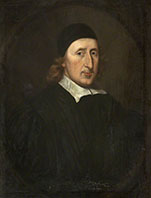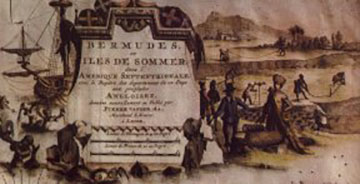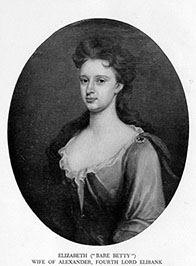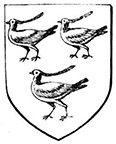
What's in a Name: some unusual names in the records

Hoolet O’Barnes, William Burnet (c.1546-1653)
William Burnet of Barns, born about 1546 in the parish of Manor in Tweedale on the border between Scotland and England became perhaps the most famous of the branch. He was known as the "Hoolet of Barns", due most likely to his keenness of sight. He is said to have been of great stature and great bodily strength and lived to the ripe old age of 107.
Burnet was a notorious border raider (reiver”; nonetheless, several of his sons entered and were successful in the legal profession, and his grandson became the notorious Archbishop Burnet of Glasgow.
He bore the nickname the ‘Hoolet of Barns' (meaning owl) on account of his sagacity in conducting midnight raids and was apparently a ‘staunch cavalier…well horsed, with a buff coat and steel bonnet, lance and sword’.
Marmaduke Dando (c.1590-1668)
Just a terrific name! Marmaduke Dando left his home in Sussex in the late 16th century and made his home in Bermuda as one of the first settlers in the island. He had a son and a grandson with the same wonderful name, and his family became one of the leading Bermuda families in the area known as Southampton Tribe.
"One wonders what men such as Richards, Leacraft, Dickinson, and Hunt thought of their neighbour Marmaduke Dando, who had taken up his lease on land in Southampton Tribe in 1617 and lived contentendly as a tenant there for most of his life. Perhaps some of them, and surely his landlord, Richard Hunt, came to comfort his family when he died on October 29th, 1668. They may have been present at his funeral the next day at Southampton Church. Marmaduke Dando was buried near the church where he had served as a reader and close by the place where he had lived for more than 50 years. He never owned any land and probably never had any slaves or servants, but as his fellow colonist Richard Norwood wrote, "May it not justly be accounted happinesse and prosperitie, for men to live where they enjoy the meanes of true religion and salvation... where the government is good without rigour and opression, the place healthfull and temperate? where they are freed from all extreame care and toyle? where they have food in abundance, and very good, with other things needful to the body?".
Marmaduke Dando probably would have agreed."
“Bare Betty” Betty Stirling (c.1680-1756)
Betty Stirling, the daughter of George Stirling, surgeon and member of parliament in 17th century edinburgh, was married at the age of 16 to Sir Alexander, 4th Lord Elibank. Each one of her five sons achieved success in the world: Patrick, her eldest, became the 5th Lord, but was known as a wit, raconteur and good friend to Dr. Johnson; George became an admiral in the navy, and accompanied Admiral Anson for part of his circumnavigation around the world; Gideon achieved high rank in the church, becoming Chaplain-General to the army, and accompanied George II at the battle of Dettingen; Alexander became a leading Jacobite and involved in the most recent plot against the British royal family, for which he spent time in Newgate prison; and General James Murray was one of General Wolfe’s seconds-in-command at Quebec, and subsequently became the first British governor of Quebec and Canada, in which country he is seen somewhat as a founding father.
So how did Betty acquire the name “Bare Betty”?
A somewhat rash Edinburgh minister when conducting "public examinations" referred to Miss Elizabeth as "Betty Stirling". This caused deep offence to the dignity of the young lady: "Mistress Betty" or "Miss Betty", she said in tones of scathing rebuke, was the style of address to which she was accustomed, but certainly not "bare Betty". Needless to say, after this incident, she was always known in Edinburgh and district as "bare Betty".
When a man, who was deeply in love with her, told her that he was ready to lay down his life for her sake, "Oh," she said, "I do not believe you would part with a little joint of your little finger for my whole body." Next day the gentleman returned, and presented her triumphantly with the joint of one of his little fingers. But he was dumbfounded when she gave him a peremptory refusal, "for," said she, "the man who has no mercy on his own flesh will certainly not spare mine." But despite this mercurial turn "bare Betty had a tender side to her character, and was much beloved by all her family.
“Muckle Mouthed Meg” Margaret Murray (lived early 17th century)
Sir Walter Scott is most credited with turning the story of Muckle Mouth Meg into the stuff of legend. The eldest son of ‘Auld’ (Old) Wat of Harden was William Scott who would succeed his father as Baron of Harden and be knighted by James VI. Harden House is still to be seen about three miles south of Hawick in the Scottish Borders as is the deep glen where Auld Wat hid the cattle he stole from the English in his many forays south of the Border.
Thus young William was a member of one of the more illustrious Scottish Border clans, the Scotts. Indeed to this day they are one of the premier landowners in Great Britain. In the Border Lands of the 16th century they were a great force, their exploits many and legendary.
Auld Wat joined forces with Walter Scott of Buccleuch in the raid on Carlisle castle in 1596 to rescue William Armstrong of Kinmont who had been imprisoned illegally by the English. It was a deed of derring-do and is remembered with pride by the Border Scots to this day.
The lands of the Harden Scotts bordered and abutted those of the Murrays of Elibank. The two families were constantly at ‘feud’ whereby each took every opportunity to steal from the other. Both families suffered from the endless reprisals.
The animosity and hatred which prevailed between the two families was to be overcome when young William was married. What began as yet another of the endless raids between the two families would have a novel outcome.
Muckle Mouthed Meg was the daughter of Sir Gideon Murray of Elibank. She was one of many daughters who blessed the union of Sir Gideon and his wife. Where some of the others were comely and attractive wenches, Meg was ugly. Her most notable feature was her mouth. Set in a face that invited derision from its angular and protruding jaw, it was wide, oh so wide; her lips were thick and full and, though conscious of the effect they had on any onlooker, Meg was a happy lass and could not refrain from smiling at any given opportunity. When she smiled or laughed her mouth seemed to cover her face from ear to ear. Embarrassed she might be but she could not refrain from giving vent to her disposition for happiness. A smile was a wonder to behold. The eligible young men of the district of Elibank were uneasy in her presence and gave its walls a wide berth.
It seemed that Meg, or to be more exact, Lady Agnes Murray, would remain unmarried much to the concern of her parents who were proud of the endearing qualities of their unfortunate daughter. She was loving, considerate and gentle, a source of great content to her doting parents. They had, however, grown resigned that their daughter would be with them until it was time for them to die.
Elibank castle, the ruins of which can still be seen, stands on the banks of the river Tweed. Fifteen miles to the south in the Ettrick valley, at another fortified tower of the Border Reiving days, Aikwood or Oakwood, lived the Scotts of Harden.
One day he his avarice overcame his common-sense and he set off with a raiding party intent on lifting Murray’s cattle. The foray went badly awry and young William soon found himself held at Sir Gideon’s pleasure. The dungeons of Elibank were dark, damp and inhospitable.
Sir Gideon was intent on making a great show of the punishment he would dole out to William and advertised to neighbours and friends far and wide that there was to be a hanging. There were all cordially invited to attend.
Lady Murray had other ideas. She was well taken by the appearance of the handsome young man and ventured the proposition to her husband that his life should be spared if he would agree to marry their daughter Meg.
Initially Sir Gideon would have none of it, but on reflection his wife’s proposal had more than one advantage. He would marry off his daughter and cement a relationship with the House of Harden. The wiles of women are sometimes hard to estimate, he thought, but this was a first-rate idea.
The handsome William knew well of Muckle Mouthed Meg. Her ugliness was renowned throughout the valley of the Ettrick water. When he was approached by Sir Gideon and offered marriage to Meg as an alternative to standing the drop that would end his life, he asked for time to consider the proposal. Eventually, though he loved life to the full, he declined the offer and resigned himself to the noose. Hanging would be quick. The thought of a life-time with Meg a far greater punishment.
On the next day he was taken up from the dungeons and out into the woods beyond Elibank. As he approached the tree from which hung the rope that would end his life he saw that Meg was standing there, tearful, ready to intercede for his life even should he spurn her. He was much taken by her solicitude and woeful appearance. As he approached the tree, the rope swinging lazily in the slight breeze, he stopped dead in his tracks. The burly men, who stood at each side of him as escorts to his death, grappled with him and tried to force him forwards. William resisted and looked at the pitiful face of the young woman, ugly as she was. She was clearly tormented by the action that was unfolding. His heart melted at the sight of her distress. He threw off his warders with a mighty and determined show of strength and ran to her open arms.
Meg and young Wat were married within a short space of time. History tells us that it was a loving union, full of happiness and respect. (from ScotClans.com)
Sir Hercules de Tyrwhitt (11th century)
Nothing whatsoever is known about the life of this wonderfully named man from the eleventh century, apart from a genealogy with no more information in it than who begat whom…. The ancient family of Tyrwhitt from Lincolnshire claim ancestry from Sir Hercules, as does the present writer!




